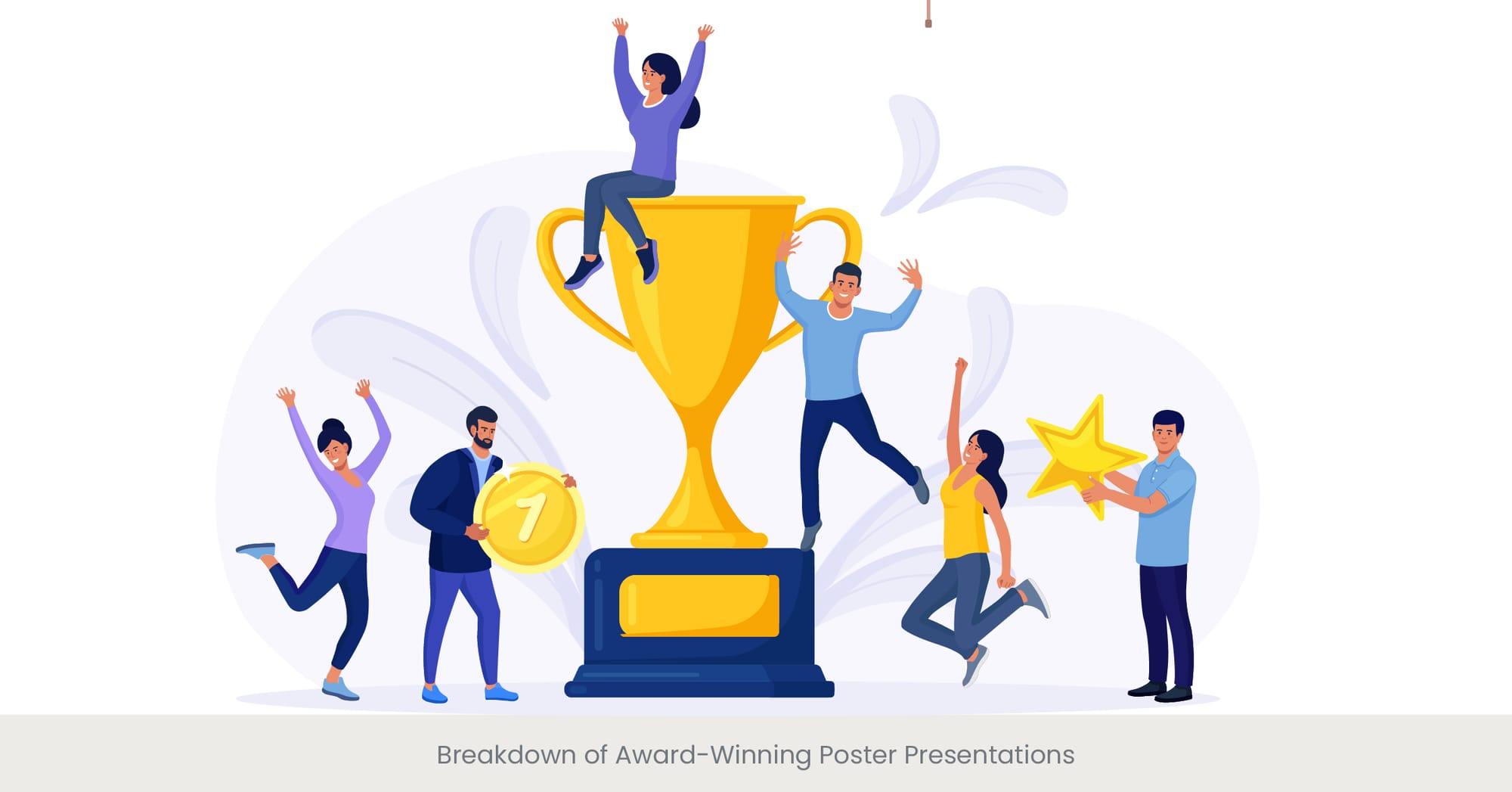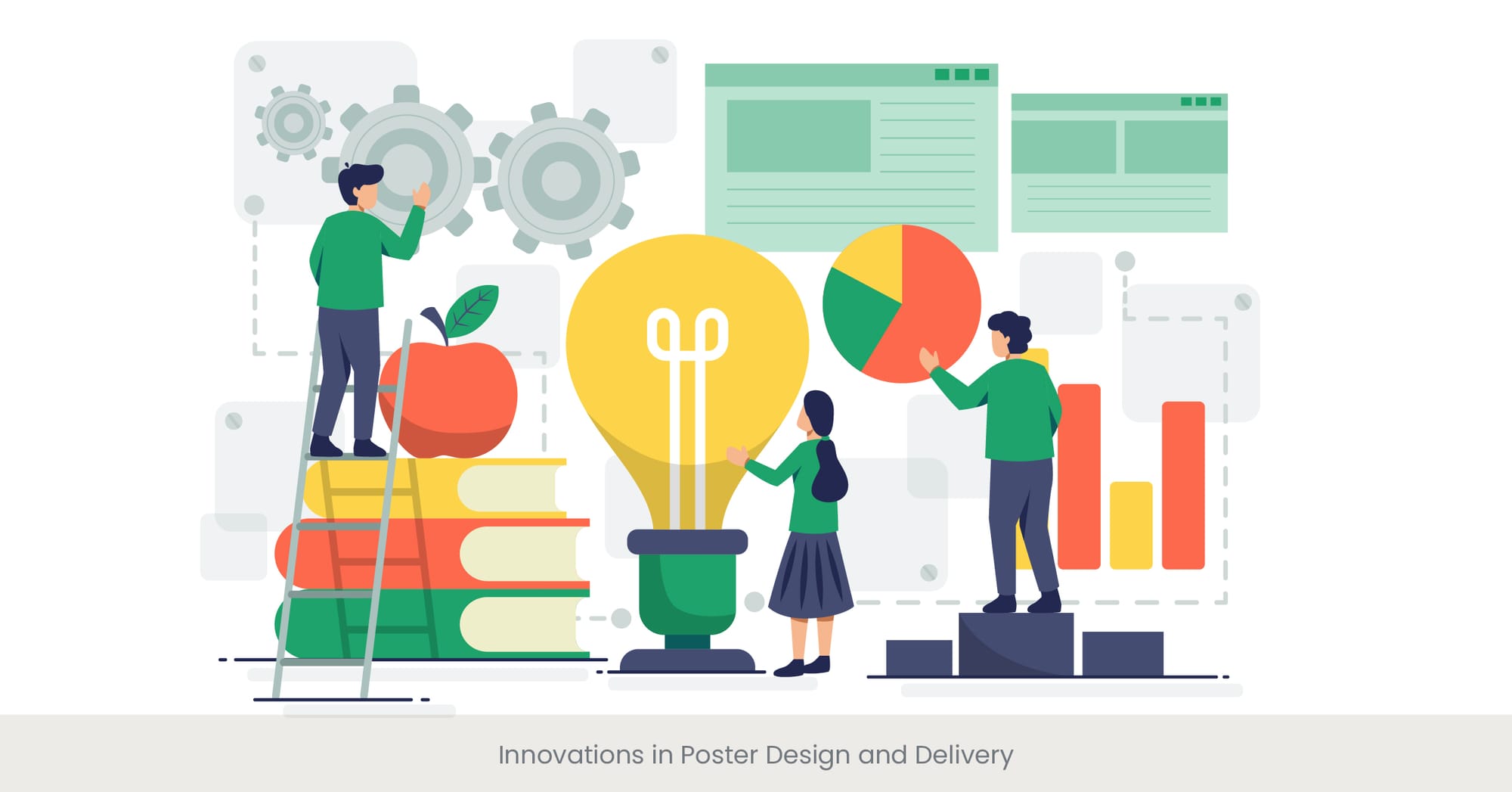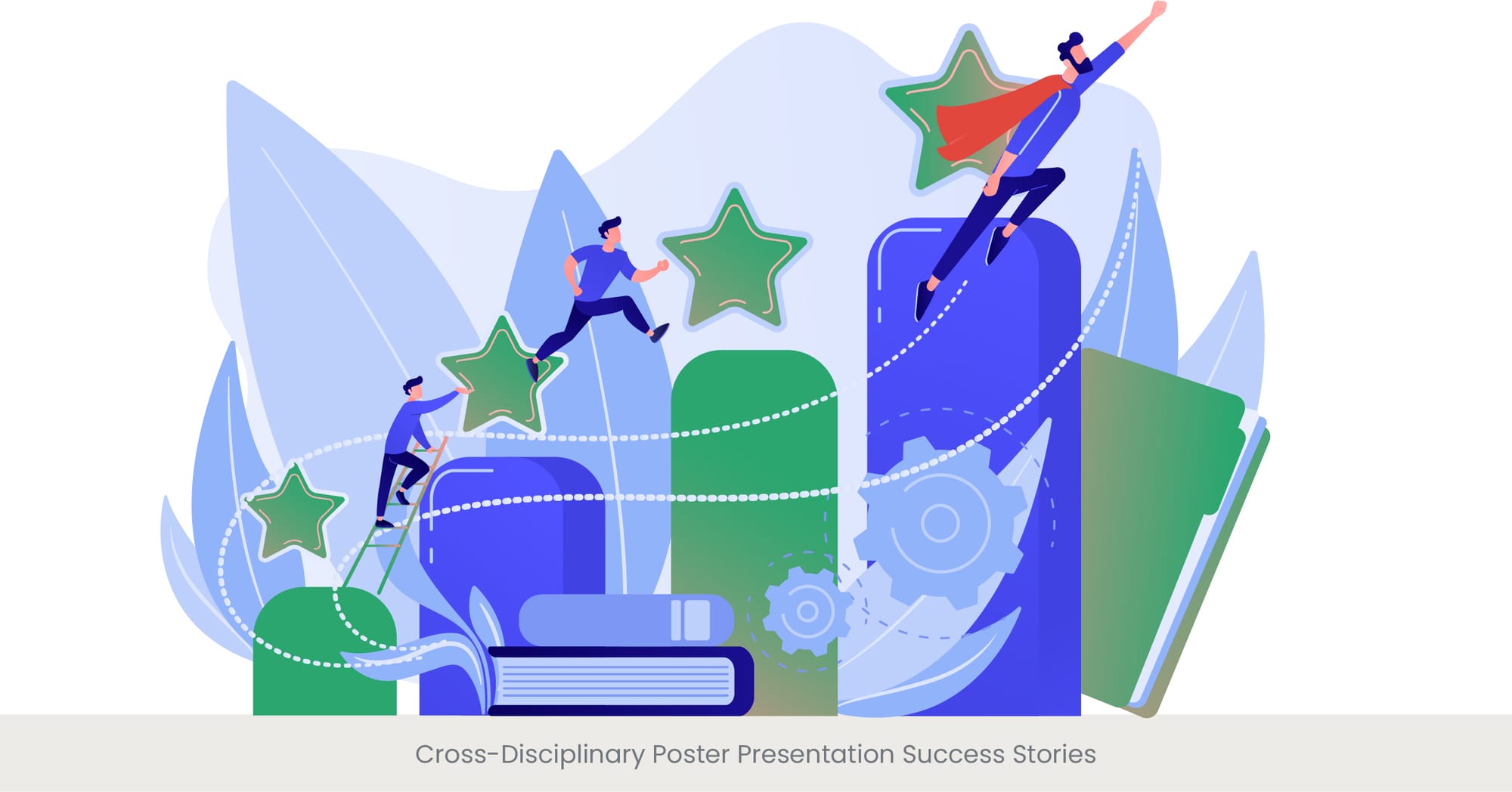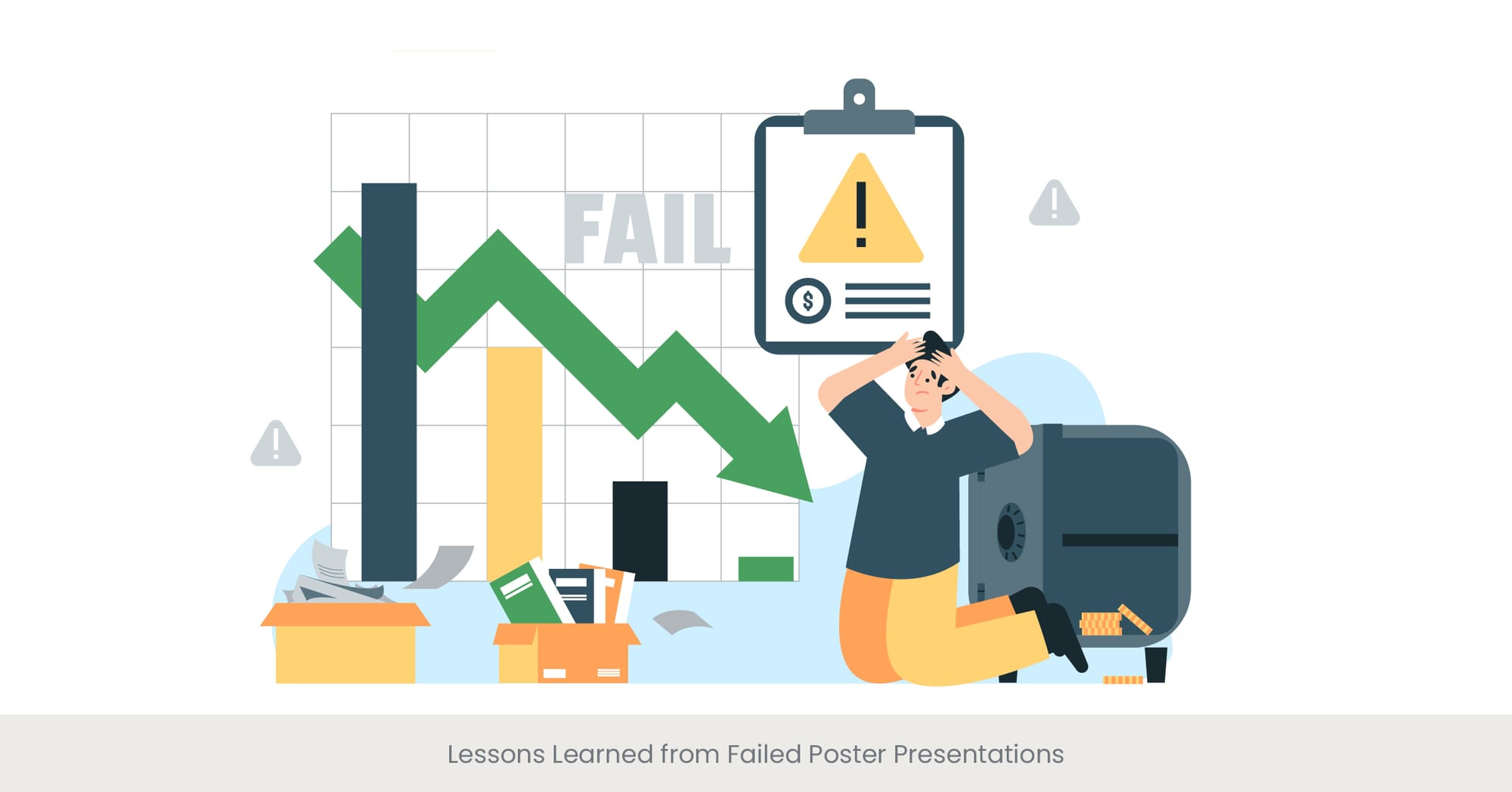
Breakdown of Award-Winning Poster Presentations

Introduction to Excellence in Poster Design
Award-winning poster presentations exemplify the pinnacle of design, content clarity, and audience engagement. These posters not only convey scientific data effectively but also captivate and communicate with their intended audience, making them memorable and impactful. Poster presentation coaching can play a vital role in shaping these successful designs by guiding presenters through the nuances of effective messaging and visual appeal.
Historical and Conceptual Framework
Historically, poster presentations have evolved from simple text-based formats to intricate designs incorporating multimedia elements and interactive content. The transition has been influenced by advances in digital and printing technology and a deeper understanding of visual communication principles. Successful designs often leverage a blend of aesthetics and functionality, adhering to the core principles of graphic design and educational communication. Effective feedback techniques for posters have become integral to this evolution, helping designers refine their presentations for maximum impact
Case Studies of Success
For instance, at the 2023 International Conference on Climate Change, a poster detailing new research on carbon capture technologies was recognized for its innovative use of augmented reality. Attendees could use their smartphones to view dynamic simulations of the processes described, significantly enhancing their understanding and engagement. This integration of technology not only demonstrated the potential application of the research but also set a new standard for interactive online virtual poster presentations. It’s clear that poster presentation coaching combined with the right technology can elevate the effectiveness of a poster presentation.
Validation Through Expert Analysis
Research published in "The Journal of Scientific Communication" highlights that award-winning posters often feature not only groundbreaking research but also exceptional clarity in data presentation and graphic design. These posters utilize high-quality images, concise text, and effective use of space, which are considered best practices in scientific poster design. Experts suggest that successful research poster templates and presentations are those that can distill complex information into accessible and engaging formats for diverse audiences. Moreover, effective messaging for posters is crucial in ensuring that the content resonates with a broad spectrum of viewers.
Innovations in Poster Design and Delivery

Pioneering New Frontiers in Presentation
The landscape of poster design and delivery is continually evolving, driven by technological advancements and creative new approaches to data visualization and audience engagement. Innovations in this area not only enhance the aesthetic appeal of posters but also significantly improve the way information is conveyed and understood. By integrating online virtual poster presentations, presenters can now engage a global audience, removing geographical barriers and enabling broader dissemination of research findings.
The Evolution of Design Techniques
Over the years, the integration of digital tools and multimedia elements has transformed traditional poster presentations. Historically, posters were primarily static displays of printed material, but now they often include interactive elements such as QR codes, touch screens, and augmented reality features. These technologies allow for a more dynamic interaction between the presenter and the audience, making complex information more accessible and engaging. A well-executed poster presentation coaching session helps individuals navigate this transition from traditional to modern presentation formats, enhancing the quality of delivery.
Highlighting Modern Examples
A notable example of innovative design can be seen in a poster from the 2022 Tech Innovators Conference, which used integrated LED screens to display real-time data updates and interactive content. This poster not only drew attention because of its big visual impact but also allowed for deeper exploration of the data through interactive graphs and models. The use of such technologies made it one of the most visited and discussed posters at the conference. This demonstrates the importance of effective messaging for posters in conveying data clearly through innovative visuals.
Scholarly Insights and Industry Impact
According to a study in "Visual Communication Quarterly," posters incorporating interactive and multimedia elements tend to receive higher engagement scores from attendees compared to traditional formats. The study suggests that such innovations can significantly increase the poster’s ability to communicate complex scientific concepts effectively. Industry experts recommend continuous exploration of new technologies and creative approaches to keep pace with the evolving expectations of academic and professional audiences. Leveraging feedback techniques for posters can also aid in understanding how to better meet audience needs.
Cross-Disciplinary Poster Presentation Success Stories

Bridging Disciplines with Innovative Communication
Cross-disciplinary poster presentations have proven particularly effective in fostering innovation and collaboration across varied fields of study. These presentations blend insights from different disciplines, creating a richer, more comprehensive understanding of complex issues. Poster presentation coaching has become essential for individuals in such cross-disciplinary teams, helping them present their diverse ideas cohesively to a wide-ranging audience.
The Evolution of Cross-Disciplinary Communication
The concept of integrating multiple disciplines has grown from niche academic experiments to a widely recognized practice essential for addressing today's multifaceted challenges. Historical examples include collaborations between biologists and computer scientists that have led to significant advancements in bioinformatics. These efforts require not only depth in individual fields but also a broad understanding of how different areas of study can inform and enhance each other.
Exemplary Case Studies
One remarkable case involved a poster presentation at the Global Health Conference 2022, where a team combined data from epidemiology, sociology, and environmental science to present new strategies for disease prevention in urban areas. This presentation was highly acclaimed for its ability to synthesize diverse perspectives and produce actionable insights, demonstrating the power of interdisciplinary approaches. Feedback techniques for posters play a critical role here, ensuring that these diverse inputs come together in a coherent and impactful way.
Recognition and Scholarly Endorsement
This approach has garnered attention in academic circles, as evidenced by articles in journals such as "Interdisciplinary Science Reviews," which highlight the increasing importance of cross-disciplinary research in advancing knowledge and solving complex global issues. Experts in academic publishing emphasize the value of such presentations in driving forward the boundaries of traditional research landscapes. Online virtual poster presentations are also helping foster this collaboration by allowing researchers from various fields to participate in global forums.
Impact of Effective Communication in Poster Success
The Core of Successful Presentations
Effective communication is the cornerstone of successful poster presentations. It involves the clear and impactful conveyance of information, ensuring that the research is not only understood but also appreciated by a diverse audience. This encompasses the use of visual aids, language clarity, and the overall organization of the poster.
Historical Context and Evolution
Traditionally, academic posters were heavily text-oriented and often cluttered, making them difficult to digest quickly. Over time, there has been a significant shift towards simplicity and visual impact in poster design. Effective communication now relies on a balance between engaging visuals and succinct text, guided by principles of graphic design and cognitive psychology to enhance viewer retention and understanding.
Real-World Success Stories
For instance, a poster on renewable energy storage solutions presented at the 2023 International Sustainability Symposium effectively used infographics and minimal text to communicate complex chemical processes and statistical data. This approach not only made the poster accessible to non-experts but also helped it stand out in a crowded field, receiving accolades for its clarity and educational value.
Validation Through Research and Feedback
Studies, such as those published in the "Journal of Effective Communication," show that posters with high visual appeal and low textual density tend to perform better in terms of audience retention and engagement. Feedback from these events consistently highlights the importance of clear, focused communication in making poster presentations successful. Recommendations often include the use of bullet points, clear headings, and the strategic use of colors to direct attention effectively.
Lessons Learned from Failed Poster Presentations

Learning from Mistakes
Failed poster presentations offer invaluable lessons that can drive improvements in future scientific communication. Analyzing these failures helps identify common pitfalls in good poster show design, content organization, and audience interaction.
Common Challenges in Poster Design
Historical reviews of poster sessions reveal that common issues leading to failure include overcrowded information, poor visual hierarchy, and lack of a clear message. These elements can overwhelm the audience, detracting from the key points the presenter wishes to convey. Understanding these mistakes is crucial for developing more effective communication strategies.
Case Studies of Notable Failures
One illustrative example is a poster from a 2021 biomedical conference, which was criticized for its overly complex diagrams and excessive jargon that alienated non-specialist attendees. The feedback highlighted the need for simplicity and audience awareness in scientific posters, emphasizing that even highly sophisticated research should be presented in an accessible manner.
Scholarly Insights and Constructive Criticism
Reflecting on such experiences, experts in academic communication recommend a focus on audience-centric design and content relevance. A study featured in "Scientific Presentation Monthly" suggests that successful posters often result from iterative design processes where feedback is actively sought and incorporated. This study advocates for pre-conference testing of posters with diverse audiences to refine messaging and visual elements effectively.
Need expert recommendations on engaging presentations?
Analysis of Audience Engagement Strategies

Engaging the Audience Effectively
Audience engagement is pivotal for the success of any poster presentation. The strategies employed to capture and maintain the attention of attendees can significantly influence the overall impact of the presentation.
Evolution of Engagement Techniques
Over the years, the methods used to engage audiences have evolved from static presentations to more interactive experiences. Historically, posters were mostly informational with little interaction. Today, successful engagement strategies include interactive elements such as QR codes linking to additional resources, interactive polls, or digital content that attendees can access on their mobile devices.
Successful Engagement Examples
A notable case in point occurred at the 2022 Environmental Science Conference, where a presenter used augmented reality (AR) to enhance their poster on coral reef conservation. By scanning the poster with a smartphone, attendees could see a 3D model of a coral reef and interact with different elements to learn about conservation strategies. This not only increased engagement but also significantly enhanced the educational impact of the poster.
Critical Analysis and Recommendations
Research on engagement strategies in "Journal of Interactive Media" suggests that incorporating elements of interactivity leads to higher retention rates and greater satisfaction among conference attendees. Experts recommend that presenters consider their audience's preferences and technological comfort levels when designing interactive posters. Additionally, providing clear instructions on how to engage with the interactive components is crucial for maximizing participation.
Ready to transform your presentation?
Use of Technology in Winning Presentations

Leveraging Technology for Enhanced Communication
In the realm of poster presentations, the integration of technology has become a defining factor for success. Utilizing technological tools not only enhances the visual appeal but also facilitates deeper interaction and understanding of complex concepts.
Historical Perspective on Technological Integration
The evolution of technology in presentations has been dramatic, shifting from simple slide projectors to advanced digital displays and interactive elements. This progression has allowed presenters to create more dynamic and engaging presentations, which significantly improve audience engagement and information retention.
Showcase of Technological Excellence
A prime example of successful technology use can be found in a poster from a recent neuroscience conference, where the presenter incorporated touch-sensitive screens that allowed attendees to explore neural pathways by interacting directly with the poster. This innovative approach not only captivated the audience but also provided a hands-on learning experience that reinforced the scientific content being presented.
Expert Analysis and Future Directions
Studies, such as those published in "Technology in Presentations Quarterly," indicate that presentations incorporating advanced technologies like AR, VR, and touch interfaces receive higher engagement scores and are more likely to be remembered by attendees. Experts predict continued growth in the use of such technologies, recommending that presenters keep pace with technological advancements to maintain the effectiveness and relevance of their presentations.
Want to incorporate cutting-edge tech into your next presentation?
Design Evolution in Successful Posters

Tracing the Evolutionary Path of Poster Design
The design of academic and scientific posters has undergone significant transformation over the years, moving from text-heavy layouts to more visually engaging and simplified designs. This evolution reflects a broader understanding of effective communication strategies in the academic community.
Historical Shifts in Poster Aesthetics
Initially, posters were often overloaded with information and photos, leading to cluttered and hard-to-read displays. Over time, designers and researchers have adopted principles from graphic design, such as minimalism and the use of negative space, to enhance readability and visual impact. This shift has been influenced by advancements in digital design tools that allow for more creative and effective poster layouts.
Exemplary Cases of Design Innovation
A standout instance of this evolution theme was showcased at the 2023 International Design Conference, where a poster on sustainable urban architecture used a combination of high-quality visuals and augmented reality elements. This poster not only provided clear, concise information but also allowed viewers to visualize future projects through a dynamic interactive experience.
Scholarly Perspectives and Future Trends
According to research published in "Design and Academic Communication," modern successful posters often utilize a blend of traditional design elements and modern technology to maximize their impact. The study forecasts that as digital tools become more accessible, poster designers will continue to innovate, potentially incorporating real-time data streams and AI-driven content adjustments to tailor messages to specific audiences dynamically.
Check out our latest case studies on poster design innovations!
Data Presentation Techniques in Successful Cases

Mastering the Art of Data Visualization
Effective data presentation is crucial for the success of any research poster. It not only communicates complex information succinctly but also makes it accessible and engaging to a diverse audience. The best presentations use data visualization techniques that highlight key findings and patterns in a visually appealing manner.
Evolution of Data Presentation
The approach to data presentation has significantly evolved from static charts and graphs to dynamic, interactive displays. Historical methods often relied heavily on textual data explanations, which could overwhelm the viewer. Modern techniques involve the use of color, contrast, and advanced graphical representations to draw attention and facilitate understanding.
Illustrative Success Stories
An excellent example of innovative data presentation was seen in a poster at the 2022 Global Data Science Conference, where a researcher used heat maps and interactive timelines to represent the progression of a viral epidemic. This method allowed attendees to engage directly with the data, exploring different time points and geographic distributions, which made the presentation remarkably effective and memorable.
Expert Insights and Recommendations
Research in "Journal of Visual Communication" suggests that successful data presentation in posters often incorporates both quantitative and qualitative insights, presented in a way that complements the narrative of the research. Experts recommend using tools like infographics and data dashboards that support audience interaction and personal exploration of the data. These tools not only enhance engagement but also aid in the retention of complex information.
Feedback and Iteration Process in Case Studies

Essential Role of Feedback in Research Presentation
Feedback serves as a critical tool for refining research presentations, enabling presenters to iterate on their designs and content based on constructive criticism and audience reaction. This process is fundamental to enhancing the effectiveness of any scientific or academic poster.
Historical Perspective on Iterative Design
The concept of iterative design in academic presentations has grown significantly with the advent of more interactive and digital mediums. Historically, feedback was often limited to peer reviews before publication or presentation. Today, real-time feedback during poster sessions can be immediately integrated, allowing for dynamic adjustments and improvements.
Case Studies of Effective Iteration
A notable example is a poster from a recent environmental science conference, which initially received mixed reviews due to its complex data visualization. The presenter quickly adapted, simplifying the visuals and incorporating clearer explanations based on live feedback. This responsive approach significantly improved the poster’s reception in subsequent sessions.
Insights from Research and Practice
Studies published in "The Journal of Academic Communication" emphasize the importance of a robust feedback loop, which includes pre-event testing, real-time audience feedback, and post-event reviews. Such comprehensive feedback mechanisms allow presenters to continuously refine their work, leading to more polished and impactful presentations. Experts recommend utilizing digital platforms that facilitate feedback collection and analysis, ensuring that presenters can promptly address any concerns and enhance their presentation's clarity and engagement.
Looking for feedback on your presentation?
Frequently Asked Questions
1. What is an academic research poster?
An academic research poster is a free visual communication tool that summarizes research with graphical displays and concise text. It allows researchers to present their work at conferences and seminars in an engaging and accessible manner.
2. How do I make an academic poster?
To make an academic poster, start by defining the main message and objectives of your research. Use a design software or a template to layout text, charts, and images clearly. Focus on making the poster visually appealing and easy to read from a distance. Incorporate key findings, methodologies, and conclusions succinctly.
3. What information should be included in an academic poster?
An academic poster should include the title of the research, the names of the researchers, an introduction to the topic, methodologies used, key findings, conclusions, and references. Visual elements like charts, graphs, and images should be used to support the data presented.
4. How do you write a research poster method?
The method section of a research poster should succinctly describe the research design, data collection, and analysis techniques. Use bullet points or numbered lists to make the methods clear and straightforward, ensuring they are understandable to the audience without excessive detail.
5. What is a good scientific poster?
A good scientific poster effectively communicates the research question, context, methods, results, and conclusions in a clear and concise format. It should be visually engaging, well-organized, and designed to attract the audience’s attention while facilitating easy understanding of complex information.
6. What are the 5 key characteristics of a scientific poster?
The five key characteristics of a scientific poster are clarity, simplicity, style, structure, visual appeal, and accuracy. These elements ensure that the poster communicates the necessary information effectively while being aesthetically pleasing and accurate.
7. What is a scientific research poster?
A scientific research poster is a tool used by scientists to present and discuss their research findings in a visual format at academic conferences. It summarizes the research project’s objectives, methods, results, and conclusions.
8. How to make beautiful scientific posters?
To make beautiful scientific posters, use a balanced layout with well-organized content and attractive visuals. Choose a harmonious color scheme, readable fonts and sizes, and high-quality images. Keep the design simple and clean to emphasize the most important information.
9. What is on a research poster?
A research poster typically includes a title, abstract, introduction, methodology, results, conclusions, and references. It may also contain graphs, charts, and photographs that visually represent the research findings.
10. Are research posters considered publications?
Research posters are not typically considered formal publications in the same way as peer-reviewed, print journal articles. However, they are important scholarly outputs that can be cited and are often included in academic CVs.



%20(1).jpg)
%20(1).jpg)


